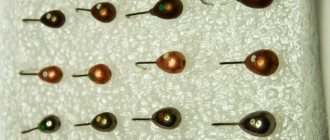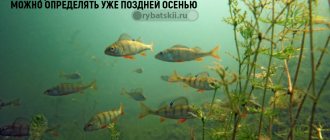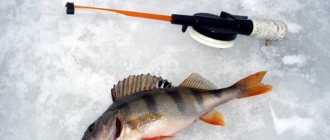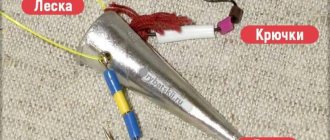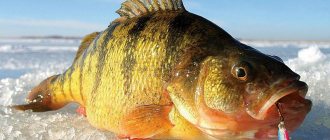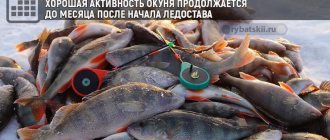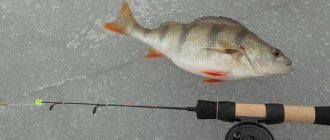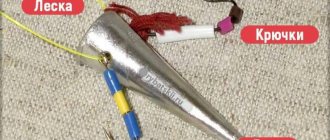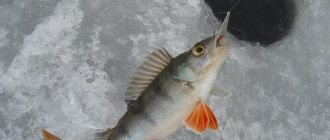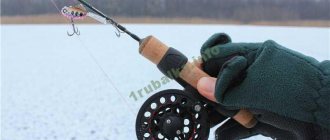The bait for perch in winter is a spoon with a hanging drop tee.
The classic crab is used as a spinner. You can also use a bait with one hook as a basis. In both the first and second cases, the spinner plays the role of an attracting element. They hit it on the bottom, causing a cloud of turbidity to rise. And the tee during pauses, with slow and gentle swinging, attracts perches.
Large perch often attacks the spoon along with the suspension, when, like a small one, it hits the drop of the tee. It is worth saying that such baits are used not only on the bottom, but also in the water column. After a long, fruitless play of the spoon along the bottom, it is raised a few centimeters into the water column and gently pumped. You can also do a subtle toss.
It is at this moment that the perch begins to show interest in the bait and attacks.
Peculiarities:
Posting is carried out in the form of rhythmic, short tosses. The lure should not be pulled very sharply! The main task of this bottom bait is to concentrate the fish at one local point. And when the density of even the most passive perches increases to a critical level, then the perch elevator begins.
This bait for perch in winter is unique in that the additional attractive element can be very different. Both a tee with a drop and a “goat”, a naked tee, a tee with hair and much more are used. The attachment of the attracting element can also be different: a small winding ring on a short retractable leash, or one freely moving along the main line. During the tosses, the “goat” moves along the main line, and during a free fall it slides down.
In this case, bites occur during pauses!
Here it is worth paying attention to the fact that the movement of the “goat” in the air and in the aquatic environment are different. Many people think that the three-piece, when moving down the fishing line, constantly stops and twitches. However, in an aquatic environment, almost any metal bait falls freely and very quickly to the bottom. When using short retrieves, the additional bait on the main line does not rise very high.
What are the best baits for catching perch?
The bait provides productive fishing for perch, which is especially voracious in winter. When choosing bait, you need to remember that perch is a predatory fish, so it is optimal to add animal components that suit the taste of this individual. But what do they use to catch perch in winter?
In this case, the ideal solution would be to use live bloodworms or jigs, since this type of animal life is capable of luring perch to the fishing point even during the non-biting season. In addition to animal bait, you can also use ready-made types of food, which, when they fall to the bottom, saturate the water and arouse interest in the area.
A large assortment of store-bought baits is presented in specialized stores. They contain special components to attract this predator. It is only important when baiting not to pour out the entire contents of the bag, but to observe the measure. You can create interest in a place by using live crustaceans.
Considering that perch is a predator with a developed sense of smell, it will be possible to arouse its interest using blood. So you can add chopped worms, shellfish, snails, and minced meat to the bait. To saturate the blood, it is permissible to mix it with breadcrumbs. Blood can also be added to a ready-made mixture purchased in a store or to porridge prepared with your own hands.
A tricky option would be to use a jar with live fry. To do this, a container containing a live fry is lowered to the bottom of the reservoir. This can be either an ordinary package or a jar. This method arouses the interest of perch, which is particularly curious.
There is another non-standard method that is used when all other attempts are in vain. To do this, animal bait, namely bloodworms or jigs, is poured into silicone molds with water, after which the molds are sent to freeze in the freezer. Afterwards, directly during fishing, the formed pieces of ice are sent to the bottom, where, gradually thawing, they arouse the interest of the perch.
Vegetable bait is also suitable for fishing. The crumbly mixture falls apart in water, resulting in a cloudy cloud. This cloud attracts the attention of small fish, which creates a fuss around the hole. Such an abundant presence of small fish in the water will certainly attract the attention of perch. To improve the result, it is recommended to add animal components to the composition, which will enhance the smell of the composition.
You can also play on the perch’s sense of smell using a flavoring agent and an attractant. It is best to give preference to the smells of bloodworms, fish or blood. You can purchase a ready-made version at a fishing store. Such additives are sold in the form of sprays, which are very easy to use.
Typical bottom spinners.
The next type of bait is typical bottom spinners.
For example, you can take the “bomb” spinner. “BOMB”
Such a spinner is played exclusively at the bottom, rhythmically knocking out a cloud of turbidity. In most cases, this bait for perch is used in winter in tandem with sliding “triples”, “goats”, “devils”, as well as “lapwings”. The first three types of additional baits are mounted on a sliding mount, on the main fishing line. But “lapwings” are used on a small diverting leash.
As in the first case, this bait is used when fish activity is low. When throwing, the spinner hits almost in one place.
Fishing tactics
Each fish has its own fishing tactics. The following tactics will help ensure the success of winter perch fishing:
- It is necessary to carefully study the bottom topography of the reservoir. Late in the evening and early in the morning, perches stay on the edges and tops of the slopes. With increased pressure, fish stay in the upper layers of water.
- In a suitable place, several holes are drilled at a distance of 4-10 meters. There can be as many holes as you like, usually 8-12.
- Each hole is fed.
- Fishing begins with the first baited hole, then all of them are fished in turn.
- If there is no bite, you need to move the holes away from the edge and try to fish all layers of water.
Very often, an angler in search of a perch must walk 10 or even 15 km, so you should be patient and be prepared for some effort.
Lure for perch in winter - cones and pyramids.
PYRAMID AND CONE
With such baits they also methodically knock on the bottom, extracting a cloud of turbidity. Cones and pyramids are often used in tandem with “goats”, “devils”, “triples” sliding along the main line.
A pyramid differs from a cone in that the first has hooks located at the corners of the faces and therefore has a wider grip. The success of fishing with this type of bait lies in the fact that you need to hit them at the same point. This must be done without deviations, with small tosses. Only in this case can you count on success!
Cones and pyramids that move to the sides during the game are not effective!
Catching lures for perch
St. Andrew's nail.
Made of two copper plates with a soldered single hook in the wide part and an eye in the narrow part, for attaching to a fishing line. The space between the plates is filled with tin. Catching perch with the Andreevskaya spoon is carried out with smooth, wide rises and a sharp drop, and the bait goes vertically, slightly deviating to the side.
Torpedo spinner.
It has a torpedo-shaped body, is made of a slightly concave plate and tin soldered onto it. Works with both single soldered and triple soldered lugs. A game. Smooth wide rise and sharp drop.
Coffin.
Loose spinner. It is made from two metal plates, both one material and different. Plays well with smooth rise and sharp release.
A tube.
Cut from various metal tubes. Length from 30 mm to 130 mm. One angle is 30 degrees, attached to the fishing line, the other 45 is attached to the tee. The most versatile spinner that can animate various games depending on the wiring and load. Plays both at shallow depths and at depths of up to 17 meters. Recommended fishing line is 0.4 mm.
“With a spoon you can catch not only a predator, but also quite peaceful fish, rudd, roach, bream.”
“Bolda.”
Well, since we’re talking about bottom baits, it would be a shame not to remember “Balda”.
“BALDA”
It consists of a main part made of lead in the shape of a pear and olive. And two side ones: in the form of hooks with beads and cambrics. With a canopy, like a cone, they methodically knock on the bottom. And during pauses, the side hooks on the bait are carefully animated. It is difficult to say what this bait can imitate, but this does not make it any less effective or catchy.
When using this bait, it is recommended to take a thick fishing line, because with bottom rigs you should not go shallow. Perch forgives rudeness, and if a trophy is caught, the angler will feel more confident while fishing.
Jig color
The color of the jig plays an important role. So, in shallow water it is preferable to use dark baits, and for depths from 2 to 12 m, silver, golden or simply yellow jigs are suitable.
The most universal colors for perch are silver-gray and lead-gray.
The presence of bright eyes on the bait can also affect the attractiveness of the jig to perch. You should try different colors and shapes to find the most suitable one for your specific conditions.
As for the weight of the jig, when selecting it, you should proceed from the depth at which fishing will primarily take place and what the strength of the current is in these parts of the reservoir.
Jigs also differ in the material they are made of, which can be used not only lead, but also tin and tungsten.
With the same size, tungsten jigs will be the heaviest, tin jigs will be the lightest, and lead lures are characterized by medium weight. These differences can be used wisely, for example, when you need a compact but heavy jig, when the perch is at depth and does not want to take a large bait.
Author of the article: Vitaly Leonidovich Ivanov, 2021.
Turtle.
And in conclusion I would like to mention one more bait - “turtle”.
“TURTLE”
According to the author of this bait, it imitates water bugs and smoothies. So you can play with a “turtle” in the water column in the same way as with a jig, or knock on the bottom. There are no beads or cambrics on turtle hooks. The reason for their absence is that the point of attack, in the form of a bright droplet, is located on the body of the bait.
The most effective “turtle” retrieve is a small toss followed by a fall to the bottom. After which the “turtle” is gently rocked or tossed at the bottom.
During such “swarming” the perch attacks the bait.
“Turtle” is a universal bait! In the water, you can “jig” it, hit the bottom or spinners, just like with vertical spinners. You can tie the “turtle” through a loop using a Rapala knot.
Ice fishing equator
By the middle of winter, everything changes dramatically; moving away from the shore, the perch gathers in large schools and begins to move almost throughout the entire reservoir in search of food and favorable conditions. At this time, you shouldn’t hope for luck at one hole, but you have to look for it, honing your drilling skills.
With the establishment of the first ice, the perch is not yet shy and practically does not leave its usual stopping places. Only with increasing ice thickness do schools of perch gradually move to deeper places. By mid-winter, the situation changes and you need to spend a lot of time searching for perch. Minke whales gather in schools and move over a large area in search of food.
How to properly tie a Rapala Knot.
But in this case, you need to be very careful to correctly pass the fishing line and tie all the components together! Otherwise, the hooks will constantly get tangled and not perform their functions - the bait will not work!
Below you will find a detailed video about the game of these baits!
